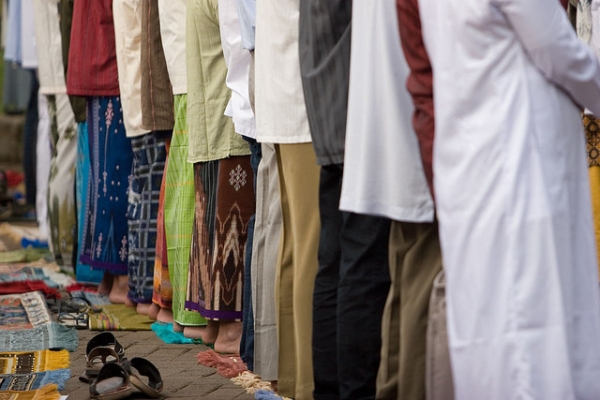

Photo by Flickr User Danumurth Mahendra (CC BY 2.0).
13 January 2015
The question of whether Prophet Muhammad can be depicted in Islam is something that perhaps most Muslims have failed to explain. With every cartoon or drawing, most people wonder why Muslims are in such an uproar – and admittedly, in some cases in a manner that is frankly unbefitting of the Prophet himself.
The story of Prophet Muhammad in Islam is one that is revered for many reasons. Yes, Muslims believe that he is God’s perfect creation, whose manners are to be exemplified. And by manners this means his overall demeanour – right down to smiling as a form of charity, greeting passers-by and respecting other religions. This is what Muslims are taught to aspire to. Prophet Muhammad is who Muslims consider to be God’s final prophet in the deliverance of His message of mankind’s divine creation (in the same way that Muslims consider Jesus, Moses, Abraham, Noah and other such figures to be messengers of the same message).
The story goes that Prophet Muhammad, an illiterate, was well into his forties when he received a divine revelation while meditating in a cave. The Angel Gabriel appeared to him and ordered him to recite what would eventually become verses in the Islamic holy book, the Qur’an. After his interaction with Gabriel, Prophet Muhammad ran from the cave in fear, trembling in the arms of his wife Khadijah as he recalled what had happened. Up until that point, Prophet Muhammad’s life had not exactly been an easy one. He was orphaned at a young age, lived mostly in poverty and worked as a merchant. A Divine revelation certainly did not make things easier for him. If anything, it made him an outcast. He was ridiculed and lampooned – so much so, that he would sometimes be left bleeding from the stones that were thrown at him. It would take Prophet Muhammad a long time to gain any following at all – least of all a community that now comprises 1.3 billion Muslims.
The story of Prophet Muhammad is one that all Muslims know well, but it is not so much this story that is often spoken about when conjuring up the memory of Islam’s prophet. Muslims are taught that even before Prophet Muhammad’s prophecy, he was considered to be a man of honour, who was trustworthy, good-natured and with a peaceful demeanour.
His sayings, known as hadith, are what Muslims often quote in times of tribulation.
But what does all that have to do with a simple cartoon or caricature? In Islam, art is not frowned upon nor is open dialogue. So what’s the big deal?
Here’s the rub: Muslims believe it was the Prophet’s express wish that he not be deemed a Deity nor worshipped as one. This is based on hadith that the Prophet is believed to have said. This means that even in the time of the Prophet some 1400 years ago, images of Prophet Muhammad were considered taboo. Prophet Muhammad believed that if pictures of him were hung on the walls of Islamic homes or shrines built of his image he would be revered as a God rather than as a man who had little more than a humble message. Idolatry was widespread in Arabia at the time and Prophet Mohammed hoped to ward this off.
Islam in many ways is based on a system of prevention rather than cure. It acknowledges human weakness such as fickle belief, doubt, jealousy, lust, anger, gossip and is designed to counter (or perhaps, more accurately, to manage) these aspects of human nature. Prophet Muhammad was well aware of this and feared that his followers would, particularly after his death, come to worship him instead of God. His wish not to be illustrated in any manner was to counter this. So when Muslims express their displeasure at cartoons or images of Prophet Muhammad it is in fact about the need to honour his wishes rather than about whether or not he is drawn with the stereotypical Arab nose and beard under some desert palm trees. The reported physical description of Prophet Muhammad is in itself vague: “(Prophet Muhammad) was neither very tall, such that he would be clearly noticed, nor was he short. He was not extremely white and neither was he very brown. His hair was neither very curly nor completely straight.”
Even in Islamic art, most notably Arabic calligraphy, it is only the Prophet’s name that is drawn – where artists try to capture his demeanour in the manner in which the Arabic letters of his name are formed. It is this kind of artwork and ‘depiction’ of the Prophet Muhammad that most often adorns the walls of Muslim homes.
It is perhaps ironic that the first verse that Angel Gabriel taught Prophet Muhammad to recite in that cave on Jabal Al-Nour, a mountain near Mecca, was how it was God who had taught man the use of the pen:
Proclaim! (or read!) in the name of thy Lord and Cherisher, Who created-
Created man, out of a (mere) clot of congealed blood:
Proclaim! And thy Lord is Most Bountiful,-
Who taught (the use of) the pen,-
Taught man that which he knew not.
But does any of that excuse the Paris shooting at Charlie Hebdo? No, of course not. Does any of that make it okay to hold innocents hostage? No, of course not. Does any of that make terrorists real Muslims? No, of course not.
A’Eysha Kassiem is a Cape Town journalist. The opinions expressed in this article are solely those of the author. No inference should be made about whether these reflect the editorial position of GroundUp.
See also: